Enlichenment in Nova Scotia
27 Feb 2019

by Fiona Brooks, Conservation Project Coordinator
Nova Scotia has entered the Age of Enlichenment! In January, over 560 Nova Scotians responded to an online poll organized by LichenNS to choose our provincial lichen. And the winner is: Blue Felt lichen (Pectenia plumbea)!

Blue-felt Lichen. Photo: Fiona Brooks.
Why do we need a provincial lichen? We already have a provincial tree – Red Spruce, flower – Mayflower, bird – Osprey, and dog – Duck Tolling Retriever, so why not a lichen too?! But it’s much more than that. There are more species of lichen in Nova Scotia than there are species of birds, mammals, fish, amphibians and reptiles combined. Lichens have an important role to play in a healthy functioning ecosystem; they contribute to nutrient cycling, provide food for animals, nesting materials for birds, and are indicators of air pollution.
A few fun facts about our new provincial lichen: it is the only species of the genus that has been found in North America, in Canada it’s only found in the Atlantic provinces, and Nova Scotia is home to the largest population in the Atlantic region. It is typically found in humid, low-lying areas where mature red maples grow, in swamps, near lakes and rivers, and in upland hardwood stands near the coast.

Blue-felt Lichen. Photo: Fiona Brooks.
It’s a fitting choice aesthetically as well – Blue Felt lichen, as the name suggests, turns a rich deep blue when wet – the perfect symbol for our coastal province. It’s relatively easy to identify with a thick gray scalloped body (thallus) topped with red-brown fruiting bodies (apothecia) all resting on top of thick fuzzy-looking dark blue fungal mat.
The Nature Trust is doing our part in protecting Nova Scotia’s provincial lichen. We have found healthy populations on our conservation lands on Gerard Island, which is in the 100 Wild Islands area. Just when you thought the 100 Wild Islands couldn’t get any more special!
